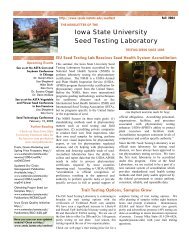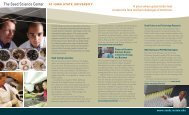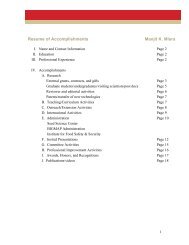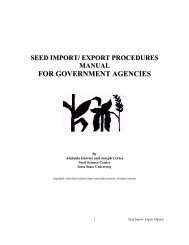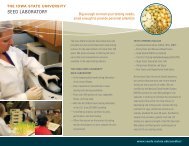Confined Production Processes for Non-Food Corn - Seed Science ...
Confined Production Processes for Non-Food Corn - Seed Science ...
Confined Production Processes for Non-Food Corn - Seed Science ...
You also want an ePaper? Increase the reach of your titles
YUMPU automatically turns print PDFs into web optimized ePapers that Google loves.
FOUNDATION SEED PRODUCTION AS A MODEL FORFIELD PRODUCTION OF PMPS AND PMISWith the exception of the scale, field trials, production offoundation (parent) seed, production of seed, and productionof PMP and PMI grain can be very similar. In field trials,the 2003 USDA–APHIS guidelines establish minimumprocedural standards. In seed production, there is additionalconcern about the impact of incoming pollen, but given thehigh standards <strong>for</strong> prevention of outflows, this concern isunlikely to materially change procedures <strong>for</strong> PMPs or PMIsin corn. In commercial production of PMPs, FDA GMPswould apply to ensure adherence to documented stringencies<strong>for</strong> confinement.The set of flowcharts developed <strong>for</strong> the field productionsection are based on foundation seed production practicein the corn seed industry. They have been modified totake into account the special process and material controlthat will be needed <strong>for</strong> some or all PMPs and PMIs incorn. In developing the good practices described here, theexisting USDA standards <strong>for</strong> confinement were consideredthe appropriate baseline; there<strong>for</strong>e, the practices are intendedto achieve confinement equivalent to this standard. Noassertion is made that they are optimal. They are a reasonablebase <strong>for</strong> models describing the relative importance ofvarious parts of the process.Foundation seed production takes seed of lines from cornbreeders in small amounts (3 to 20 kg) and increases thelines to amounts of a few hundred kilograms or more <strong>for</strong>use to plant field where hybrid corn seed is produced. Theplants in foundation corn seed fields are the grandparents,or great grandparents, of the plants in ordinary cornfields.The scale of foundation seed production is similar to thescale that would be appropriate <strong>for</strong> many plant-manufacturedpharmaceuticals. The entire U.S. corn industry only requiresapproximately 5,000 tons of foundation seed per year.Foundation seed only represents roughly 1/50,000 of theU.S. commercial corn crop.Any accumulation of impurities in foundation seedproduction is cumulative. Thus, special procedures havebeen developed that ensure high standards of purity. Thepriority in conventional foundation seed production isthe opposite of the challenge in producing PMPs andPMIs in corn. The challenge is to prevent pollen inflowsrather than pollen outflows. Because isolation worksthe same in either direction, the purity procedures <strong>for</strong>foundation seed production provide isolation in the waythat would be desirable <strong>for</strong> production of PMPs and PMIs.Foundation seed corn is valuable. Prices can be $15 perkilogram or higher. Thus, practices have been developedthat not only ensure its purity but also ensure that seed isnot lost in handling. In this respect, foundation seed proceduresare similar to the procedures that should be used<strong>for</strong> PMPs and PMIs.Foundation corn production techniques are not verywell documented in published literature, but hybrid seedproduction techniques are documented and serve as goodbackground <strong>for</strong> the processes being described here. Onegood source is Wych (1998). It includes a brief descriptionof foundation seed stock increase (pp. 568-569).McDonald and Copeland (1997) is an in<strong>for</strong>mative source<strong>for</strong> seed production in<strong>for</strong>mation, including sections onseed certification and corn which explain the role offoundation seed. The global corn certification standardsunder OECD also explain the higher standards thatdifferentiate foundation seed production (OECD, 2003).Foundation corn seed production can best be describedin contrast to the characteristics of hybrid corn seedproduction. Hybrid seed corn production in turn can becontrasted with commercial seed corn production.Characteristics of hybrid seed production in the fieldinclude the following:• <strong>Production</strong> takes place under the management ofexperienced professionals.• Teams are specially trained to per<strong>for</strong>m procedures.• Most major production companies are ISO certified.There are written procedures <strong>for</strong> all processes.• Written records are kept of all important activities.Record keeping is supported by computer systems sothat any problems can be tracked.• Locations and contract growers are chosen carefully tomaximize quality and minimize cost. Growers are likelyto be among the most progressive farmers in the area.• Isolation standards are maintained in the productionfield. Neighboring fields are routinely inspected <strong>for</strong>problems with isolation. <strong>Seed</strong> production has isolationstandards. Commercial field corn production does not.• Field production practices are optimized <strong>for</strong> the particularline being grown.




